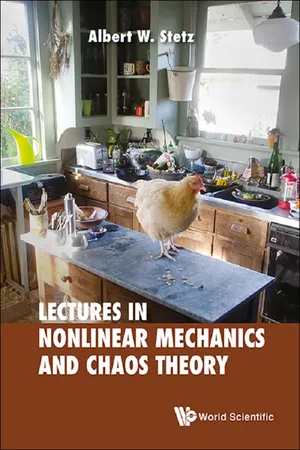
- 150 pages
- English
- ePUB (mobile friendly)
- Available on iOS & Android
Lectures on Nonlinear Mechanics and Chaos Theory
About this book
This elegant book presents a rigorous introduction to the theory of nonlinear mechanics and chaos. It turns out that many simple mechanical systems suffer from a peculiar malady. They are deterministic in the sense that their motion can be described with partial differential equations, but these equations have no proper solutions and the behavior they describe can be wildly unpredictable. This is implicit in Newtonian physics, and although it was analyzed in the pioneering work of Poincaré in the 19th century, its full significance has only been realized since the advent of modern computing. This book follows this development in the context of classical mechanics as it is usually taught in most graduate programs in physics. It starts with the seminal work of Laplace, Hamilton, and Liouville in the early 19th century and shows how their formulation of mechanics inevitably leads to systems that cannot be "solved" in the usual sense of the word. It then discusses perturbation theory which, rather than providing approximate solutions, fails catastrophically due to the problem of small denominators. It then goes on to describe chaotic motion using the tools of discrete maps and Poincaré sections. This leads to the two great landmarks of chaos theory, the Poincaré–Birkhoff theorem and the so-called KAM theorem, one of the signal results in modern mathematics. The book concludes with an appendix discussing the relevance of the KAM theorem to the ergodic hypothesis and the second law of thermodynamics.
Lectures on Nonlinear Mechanics and Chaos Theory is written in the easy conversational style of a great teacher. It features numerous computer-drawn figures illustrating the behavior of nonlinear systems. It also contains homework exercises and a selection of more detailed computational projects. The book will be valuable to students and faculty in physics, mathematics, and engineering.
Contents:
- Lagrangian Dynamics
- Canonical Transformations
- Abstract Transformation Theory
- Canonical Perturbation Theory
- Introduction to Chaos
- Computational Projects
Readership: Students who want to learn the subject of nonlinear mechanics and chaos theory from first principles.
Key Features:
- It presents chaos theory as a logical consequence of the traditional formulation of classical mechanics
- It is fine-tuned to the requirements of a graduate course in physics
- It contains numerous computer-drawn figures illustrating the behavior of chaotic systems, figures that are not available in any other book
Frequently asked questions
- Essential is ideal for learners and professionals who enjoy exploring a wide range of subjects. Access the Essential Library with 800,000+ trusted titles and best-sellers across business, personal growth, and the humanities. Includes unlimited reading time and Standard Read Aloud voice.
- Complete: Perfect for advanced learners and researchers needing full, unrestricted access. Unlock 1.4M+ books across hundreds of subjects, including academic and specialized titles. The Complete Plan also includes advanced features like Premium Read Aloud and Research Assistant.
Please note we cannot support devices running on iOS 13 and Android 7 or earlier. Learn more about using the app.
Information
Chapter 1
Lagrangian dynamics
1.1Introduction

1.2Generalized coordinates and the Lagrangian
Table of contents
- Cover
- Halftitle
- Title Page
- Copyright
- Preface
- Contents
- 1. Lagrangian dynamics
- 2. Canonical transformations
- 3. Abstract transformation theory
- 4. Canonical perturbation theory
- 5. Introduction to chaos
- 6. Computational projects
- Appendix A Measure theory and the ergodic hypothesis
- Bibliography
- Index